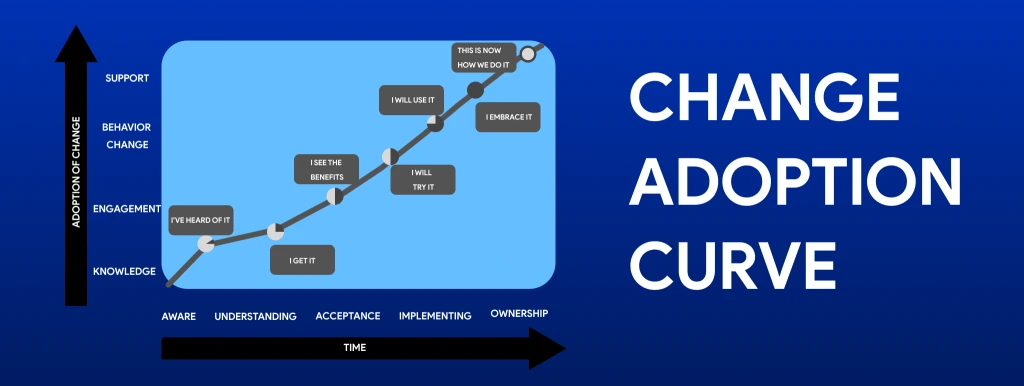How to Drive Change Adoption: 5-Step Digital Transformation Plan?
10 Jul 23 


Digital transformation is now a continuous process. It’s a continuous, developing process for organizations that offers business possibilities as well as IT obstacles at each stage. Organizations must be ready with more than a straightforward change management strategy since change is the only thing that is certain.
Through an online adoption-focused enabling change strategy that concentrates on delivering relevant consumer advice, assistance, training, and holistic experiences, organizations have to view change initiatives from the standpoint of their consumers and workers.
Only 18% of commercial organizations, according to the Economist Intelligence Unit, have effectively merged front- and back-office operations. Of those, barely 10% are adopting digitalization. These market analyses paint an overview of the actual situation that is quite apparent.
It’s simpler than it appears to embrace technology. Innovations, employees, and crucial company procedures will all be needed to convert conventional company activities into completely digital processes. Therefore, each of these elements will be crucial to the project as a whole.
In 2016, there will be a sharp increase in the number of promises made to “Digital Transformation” activities, predicts IDC’s Futures cape research. Companies go digital out of an impulse to give clients a superior digital experience.
It is crucial to talk about the importance and necessity of digital transformation in this context. Let’s create an outline for this conversation to help us maintain awareness of the value of digital transformation and the best practices for implementing it.
What is Digital Transformation?
The method of leveraging digital technology to develop new or enhanced processes, goods, or services is known as a digital transformation. This can be accomplished by either building novel procedures or refining the ones that already exist. The process of going through a digital transformation has several advantages.
The ability to increase efficiency and reduce costs for enterprises is arguably the most significant benefit. The rise of fintech apps makes the payment and remittance process more feasible. The digital transformation played a key role in evolving contactless payment and digital payment methods, easing the money transfer process.
Along with boosting income, it may also help promote customer happiness and loyalty. Utilizing customized loyalty programs, this is achievable. Additionally, by adopting more creative product engineering processes, a digital transformation may assist firms in being more flexible and changeable.
Change Adoption – Definition
The last stage of the change management cycle, change adoption, allows the digital acceptance of innovative technologies, digital processes, organizational structure adjustments, customer service, or any task involving the execution of a change. Using in-app advice, autonomy, user assistance, user behavior analytics, behavior modifications, and reinforcing nudges, change adoption helps new digital apps or processes succeed and be sticky.

5-Step Digital Transformation Plan
The majority of organizations today are aware of the value of a digital transformation process. We have created a five-step procedure to assist organizations in adopting a strategic plan for change approval. These five phases are essential accelerators to achieving success with digital transformation, given the experience we have with conducting digital changes.

Acknowledge Digital Transformation Challenges
Not every digital transformation is simple or seamless. There are several obstacles that impede or lag digital transformation activities, including:
- Change Reluctance
Stakeholders and workers can be reluctant to transformation, particularly if they feel at ease using the current procedures and methods.
- Poor knowledge & experience
Because of the speed at which technology is evolving, it is frequently difficult for organizations to recruit personnel who have the knowledge and experience necessary to successfully execute and oversee digital transformation initiatives.
- Opposition from traditional operations
Digital transformation may disrupt established business workflows and methods, necessitating cultural change management and adaptation on the part of organizations.
Create a Distinct Goal
An explicit goal and mission statement must be the first step in the digital transformation process. Here’s how to make that happen:
- Set the overarching aims and goals
Organizational leaders ought to have an obvious understanding of what they intend to accomplish through digital transformation, including bettering client experiences, boosting productivity, or improving the analysis of data.
- Determine those areas that need to be transformed
According to their impact on the company’s goals and viability, select which projects are most important to undertake.
- Create a plan
Make an extensive plan that explains the activities necessary to reach the goal state, encompassing technological advancements, process enhancements, human resource development, and cultural adjustments.
Lay a Solid Digital Foundation
Organizations seeking to effectively execute digital transformation must first establish a solid digital platform. This helps organizations fully utilize the latest innovations by providing the required facilities and skills for assisting digital activities.
The following are some pointers for establishing a solid digital base,
- Latest technological investment
Invest in cutting-edge, flexible technological infrastructure that can enable digital efforts, such as network connectivity, low-code/no-code applications, cloud-based data management systems, and cloud computing.
- Participate in the current group
Engaging in your current workforce pays off considerably compared to recruiting new personnel. Your employees may support digital goals despite staying advanced in comprehending the current company by giving them the opportunity for training.
- Employ confidentiality and data safety strategies
Ensure that the digital infrastructure is protected by strong safety precautions to fight against online attacks. As part of this, risks must be recognized and managed, security precautions must be put in place, civic program management must be supported, and the plan must be tested and updated frequently.
Having a solid digital foundation raises the chances that your digital transformation projects will be successful and paves the way for future development and achievement.
Promote Employee Involvement
A crucial component of the achievement of projects for the digital transformation is promoting employee engagement. The following are some strategies to promote employee engagement:
- Upskill
Give staff members the chance to develop the expertise and abilities necessary for the digital transition. Continual learning, like acquiring new languages, is key for self-growth and navigating technological shifts. Utilizing German learning platforms with lessons from expert teachers can effectively boost one’s digital skills and global communication capacities. This covers instruction in cutting-edge methodologies, procedures, and best practices. Team trust and participation in the program may be increased through training and development.
- Rewards and recognitions
Reward staff for their efforts in the digital transformation effort by recognizing and rewarding them. Programs for acknowledgment, advertisements, and rewards may fall under this category. Encourage digital transformation success by helping employees recognize achievements with awards. Celebrate milestones and innovation through thoughtfully selected employee recognition trophies, enhancing motivation and acknowledging contributions towards change.
- Encourage a collaborative culture
Promote multidisciplinary cooperation and teamwork. Establish an environment where employees feel valued and free to express their thoughts and observations. Many technologies support digital transformation by enhancing teamwork and coordinating IT with company demands.
Success Metrics and Ongoing Development
A strong digital transformation strategy must include metrics for achievement and ongoing development. Here are some important elements to take into account when determining effectiveness and promoting continual enhancement:
- Set defined objectives and metrics
This is also known as key performance indicators, or KPIs) for the digital transformation program. Then, create a system for monitoring and evaluating the program’s progress towards these objectives. These KPIs must be frequently evaluated and changed as necessary in order to stay in line with the goals and targets of your organization.
- Track the transformation process’s development
Maintain periodic achievement evaluations against KPIs, and utilize data and analytics to pinpoint areas that require development.
- Adjust & enhance the process
The process should be adjusted and improved as needed. Periodically evaluate the success of the digital transformation program and utilize the results to guide any needed modifications. Increase the efficacy and productivity of procedures, including technological advances, the handling of data, and interpersonal relations. The process of digital transformation is ongoing and fraught with difficulties.
It involves traversing complicated technology environments, dealing with possible cybersecurity threats, and making sure digital efforts are in accordance with more general corporate objectives. Furthermore, investing heavily in new technology and training employees may be necessary for digital transformation, this can be realistic for all organizations.
Wrapping Up
Digital transformation is without any doubt one of the most crucial activities that companies must carry out to remain viable and effective. You can be comfortably on your way to effectively executing a digital transformation plan inside your company if you stick to the instructions provided in this blog.
When organizing and carrying out your transformation, keep in mind to prioritize the demands of your clients, team members, and other stakeholders; by doing this, you’ll ensure that your company is prepared for achievement. If you are looking for assistance in integrating digital transformation into your company, we at Mindster are a well-known mobile app development company that provides solutions to its clients.
We can provide information that will help firms discover their digital strategy’s flaws and make optimal investments in open technologies. By comparing your operational efficiency and business models to those of the best in the sector, we help you engage with customers.
- Agentic AI1
- Android Development3
- Artificial Intelligence31
- Classified App3
- Custom App Development5
- Digital Transformation12
- Doctor Appointment Booking App14
- Dropshipping1
- Ecommerce Apps40
- Education Apps2
- Fintech-Apps37
- Fitness App4
- Flutter4
- Flutter Apps20
- Food Delivery App5
- Grocery App Development1
- Grocery Apps3
- Health Care10
- IoT2
- Loyalty Programs9
- Matrimony Apps1
- Microsoft1
- Mobile App Maintenance2
- Mobile Apps125
- Product Engineering6
- Progressive Web Apps1
- React Native Apps2
- Saas Application2
- Shopify9
- Software Development3
- Taxi Booking Apps7
- Truck Booking App5
- UI UX Design8
- Uncategorized6
- Web App Development1



















Comments